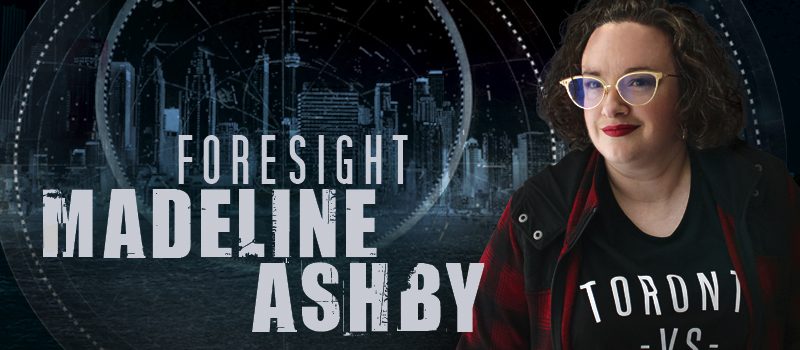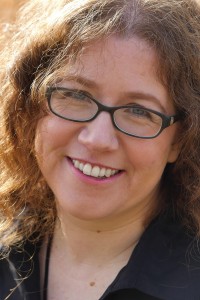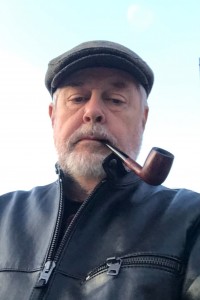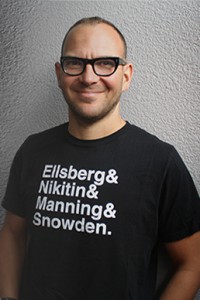Madeline Ashby: Foresight

Madeline Ashby was born April 24, 1983 in Panorama City CA and grew up in Washington State, outside Seattle, before relocating to Canada in her early twenties. She graduated from Seattle University in 2005, and went on to get an M.A. from York University in Interdisciplinary Studies with a focus on ”Japanese animation, cyborg theory, and fan cultures.” She then attended the Ontario College of Art and Design University, where she earned an M.Des. in Strategic Foresight and Innovation with a focus on the future of border security.
She began publishing short fiction in 2007, and her first professional sale was ”The Chair” in Nature (2009). Her story ”Domestic Violence” (2018) was a Sunburst Award finalist.
Debut novel vN appeared in 2012 and was a finalist for the Kitschies’ Golden Tentacle Award. The Machine Dynasties series continued with iD (2013), and third volume ReV is forthcoming in July. Standalone novel Company Town was published in 2016; it won a Copper Cylinder Award and was a finalist for the Aurora Award, and a finalist in the 2017 CBC Books Canada Reads competition. It is now in development for television. She has another standalone near-future novel forthcoming.
With husband David Nickle, she edited Aurora Award finalist Licence Expired: The Unauthorized James Bond (2015). She was one of the writers on tie-in serial Orphan Black: The Next Chapter for Serial Box (2019). Ashby was nominated for the John W. Campbell Award for Best New Writer on the strength of her debut novel, but recused herself due to an earlier professional story publication that made her ineligible.
In addition to writing, Ashby works as a futurist, with clients including Intel Labs, the Institute for the Future, and more. She runs workshops on the impact of future technologies, and publishes non-fiction widely in that field. She co-wrote non-fiction book How to Future (2020) with Scott Smith of Changeist.
Ashby married her first husband shortly after moving to Canada; they later divorced. She met Stoker Award winning horror writer and journalist David Nickle in a writing workshop in 2006, and the two married in 2015. They live in Toronto.
Excerpts from the interview:
“My dad was a science fiction fan, and he had some classics around – Heinlein, Frank Herbert, Asimov’s Foundation omnibus. I gravitated more towards the Frank Herbert side of his collection. My mother was the avid reader, though – she always had a book in her hand, she started a book club, and she took me to libraries all the time. I was the kid who left the library with the sack of books that was coming apart – they would give us these plastic bags, and all the edges of the books poked out and created little tears. She was the one who instilled the habit of reading in me. She would read anything – biographies and true crime, and a lot of mysteries. When I was a kid I was a huge mystery fan, in part because of her influence. She also read a lot of classics. She was the one who gave me my first copies of Jane Eyre and Rebecca. She also introduced me to Stephen King. Dad had a bunch of classic science fiction writers, and she had the Stephen King shelf. The only time I remember her not allowing me to read something was when I picked up The Stand at about age eight, and she thought that was a little much. When I picked it up again at 14, there was no issue. She presented David and me with her first edition of The Gunslinger, with the Whelan illustrations, as a wedding present. It’s beautiful. It’s a touchstone for both of us – something she passed on to me that I found myself sharing with somebody else.
“I was always a storyteller. When I was a very small child, I would wander around my room rehearsing stories that I made up, and I would tell them orally and use funny voices. I would rehearse the same scenes over and over. That habit has stuck with me, though I don’t do it aloud anymore. I rehearse the same scenes over and over and block them out. I hear what my characters are going to say before I ever type it; I know what that scene looks like, what the room looks like, and the tenor and pitch of the voice that is saying the words. A lot of my writing is dialogue-heavy for that reason.
“The first major writing project I had was in grade nine. I was part of an AP or honors history class where I read The English Patient, and it put me under a spell. My teacher, to whom I once dedicated a book, was a Fulbright scholar sort-of trapped in the public school system. As part of an ancient civilizations assignment, he had us write a story either set in that time period or about that time period. We had to exposit all the information we had covered in the unit and everything we had researched in a compelling, memorable, engaging, thoughtful way, in a narrative with a beginning, middle, end, and a turn, and so on. I wrote a story about archaeologists in the Mohenjo-daro baths who find a skeleton that shouldn’t be there. Mine was like 35 pages long, and everyone else turned in five or ten – I had written a novelette or a novella. He looked at that, and I thought I was in such trouble, because he said, ‘Madeline, we have to talk.’ He pulled me outside and I said, ‘Did you not like it?’ He said, ‘There’s room for improvement, but that’s not the point. I have an offer for you. I want you to continue doing this for every unit that we cover in class for the whole year. If you do, and if you agree at the end to submit your work to publishers, I will give you an A for the rest of the year. You’ll get top marks, and you won’t have to do any other homework or assignments or tests in this class, as long as you commit to seeing this through with me. Will you do that?’ I agreed, and that ate my life for the entirety of grade nine. The book didn’t go anywhere, because it was rife with cliché, the kind of thing you write when you’re 14 or 15, but it was the first time I saw a major project through. After that, I knew I could do it. I could finish things. I could stick to something. That stood me well. I went to a Jesuit university and did two departmental honors projects in history and English, because those were my majors, and then I did two master’s degrees. I also write novels. If not for that experience of just sitting down in the chair, I wouldn’t have known I could do that. When I think about the ideal writing experience and the time I was happiest as a writer, I think back to being 14, when I felt that flowing through me and had that first-timer hunger and drive and eagerness.
“I met my husband David Nickle in a writers’ workshop that I auditioned for when I came to Toronto in 2006. I studied at Seattle University and married into Canada, essentially. I was getting my first master’s degree in interdisciplinary studies – I was focused on Japanese animation, cyborg theory, and fan culture – and at the same time I was also cutting my teeth at the Cecil Street Irregulars, technically the longest-running genre workshop in Toronto. When I first came to Canada, I couldn’t work and I couldn’t study, because I didn’t have those visas – all I could do legally was hone my craft. I started asking around, and someone on the IAFA listserv said, ‘You should talk to Chris Szego at Bakka-Phoenix Books.’ I sent an email to Chris, and said, ‘Hi, I’m in this strange situation – who would you suggest I speak to?’ She pointed me at David, and I asked about the workshop, and the workshop said, ‘Let’s have her audition. She’s a complete stranger; we have to make sure that she’s not an axe murderer or something.’
“Apparently everyone thought I was a 50-something divorcee who was just getting her life back, because of the tone of my letter. In fact I was just new to Canada and worried about being as polite as Canadians are supposed to be, and so I was really formal in my request. They said I could send a story, and if they liked it, I could bring in another piece for critique. They do the Milford model, where you sit in the hot seat and don’t reply until it’s the time for your rebuttal. But I was ready, because in the honors program at the Jesuit university I had attended, I had oral finals for the first two years, so for history, literature, and philosophy, my final exams were whatever my teachers decided to ask me in the moment. Sometimes the questions were printed ahead of time, other times they came out of a hat, and other times they were just what the professors felt like talking to you about. Once I had to answer a question about how the use of stock characters in Roman theatre compared to the use of stock characters in network television, so I compared Seneca to Dick Wolf. You were responsible for the information, so I knew how to handle the audition. There’s been a weird sort of overlap between my academic experiences and my writing experiences. Nothing will train you for a graduate school defense like having your personal creative work taken apart and problematized by professionals who have been publishing for a lot longer than you have. So when I defended my first master’s thesis, I was able to listen to this roomful of people just ripping apart the work, and be very patient. I knew how to navigate that emotionally.”
“My first professional publication, the one that started my Campbell clock, was a publication in Nature in 2009, called ‘The Chair’, about a person who was definitely not Stephen Hawking having their entire existence taken over by the AI that is built into their attendant devices. When this person eventually persuades a space agency to send them off somewhere, it’s entirely the device’s doing, and it’s the device that wants to travel.
“My novel vN came out in 2012. I first pitched it to Angry Robot at Montreal Worldcon in 2009, and I wasn’t done yet. That was also the summer I signed with my first agent. I’m still with that agency, although I’m with a different agent now, Sally Harding at CookeMcDermid. She’s lovely. I think she’s a lot of people’s favorite person. I made the pitch to Angry Robot because at that time they were emerging. I was pitching Angry Robot on a book about an angry robot, so it was very on brand. I was terrible at the pitch. Awful. I didn’t have a logline or a high-flown concept way of describing the book. I talked their ear off for half an hour at this very loud party, which is exactly the opposite of what you should do. I was that person. I was 26. I’m embarrassed for myself just thinking about it. We sent the book around, and Angry Robot expressed interest in December of 2010, and in June 2011 they bought it. I turned in the contract at the same time I was turning in my second master’s thesis, which is an experience I don’t necessarily recommend. The book was written, but I ended up taking out a lot and putting in new material during the editorial process. They bought it as a duology, and then they wanted another one, so it went from a duology to a trilogy. I finished the third one, reV, while in Geneva for the UN AI For Good conference in 2019. I completed a book about AI at a conference about AI, in the same city where Mary Wollstonecraft Shelley wrote Frankenstein. After so long, finishing it there seemed meant to be.”
Interview design by Francesca Myman. Photo by Liza Groen Trombi.
Read the full interview in the June 2020 issue of Locus.
 While you are here, please take a moment to support Locus with a one-time or recurring donation. We rely on reader donations to keep the magazine and site going, and would like to keep the site paywall free, but WE NEED YOUR FINANCIAL SUPPORT to continue quality coverage of the science fiction and fantasy field.
While you are here, please take a moment to support Locus with a one-time or recurring donation. We rely on reader donations to keep the magazine and site going, and would like to keep the site paywall free, but WE NEED YOUR FINANCIAL SUPPORT to continue quality coverage of the science fiction and fantasy field.








